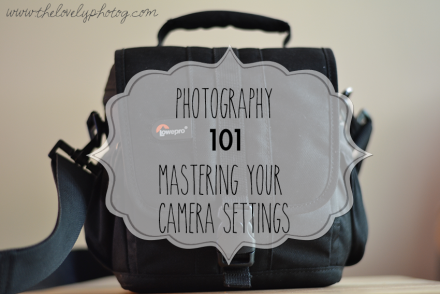Welcome to the first week of my new
Photography 101 Series: Mastering Your Camera Settings!
This is basic beginner photography knowledge and tips that can help you on your photography journey—whether you are a blogger, photographer or hobbyist.
This series will be broken down in 3 parts and the first post can be found here of the breakdown of each subject in the series.
So lets begin…
Part I: Understanding Exposure
- ISO
- Aperture
- Shutter Speed
The three elements (exposure triangle), ISO, Aperture and Shutter Speed help to make up the main components of exposure in your camera. Exposure meaning the amount of light measured in units that allows it to reach the electronic sensor in a digital camera.
What is ISO?
ISO measures how sensitive the camera is to light. In most cameras, ISO speeds are 100, 200, 400 and 800. These speeds can increase with the level of camera that you purchase (point and shoot vs dslr).
*Quick Tip- Lower ISO= Less Grain/Noise Higher ISO=More Grain/Noise
What is Aperture?
Aperture controls how much light enters the camera through the lens. Aperture allows you to be able to adjust the depth of field in a photo. Aperture is my favorite mode on my camera, because I love taking macro (up close) shots. Depth of field determines how much of the subject is in focus and how much the background will be blurred.
*Quick Tip- Shallow Depth of Field= f1.4-f5.6 ( More Light+ Blurred Background) Deep Depth of Field=f8-32 ( Less Light+ Background in Focus)
What is Shutter Speed?
Shutter Speed (exposure time) is how long the light entering through the lens (aperture) exposes the sensor. The shutter speed is very important, especially when shooting moving subjects. The shutter speed completely determines the motion blur or sharpness of the subject in your picture. Shutter speeds range from 1/30-1/4000 fractures of a second.
*Quick Tip–Slower Shutter Speed=Slows Motion (1/30 or slower) Faster Shutter Speed=Freezes Action (1/250 or more)
So that was a quick review of understanding exposure. I hope this gives you a better understanding of learning to use the light to your advantage in photography.
I’ve also found a great infographic with all of the important information for understanding exposure.
Tell Me…
What type of camera do you use?
Will you try and adjust your settings on your own now that you understand exposure?
More information on Camera Exposure here

 Source: Filmmaker IQ
Source: Filmmaker IQ
I own a Nikon D3100 and I take OK pictures but I really want to do better. My biggest problem is that the pictures aren’t sharp but I also noticed that on the preview the pictures look perfect but on my computer not so much (usually underexposed). So I’m going to play around with the settings a little bit more…
Thank you for the series.
That was my first dslr too. Along with shutter speed and focus features, the lens can offer tack sharp pictures as well. Prime lenses are great for that 🙂 Resizing pictures for the web are pretty tricky. I still struggle with that too. The computer and social sites can really make pictures look different. I’ll be posting about resizing in the future 🙂 Thank you so much for reading 🙂
I have a Canon Powershot SX40 that I used for videos and mos tof my photos so I’m not in the DSLR league as yet 😉 These tips were helpful for when I upgrade. Thanks LeSha 🙂
You’re welcome! 🙂
So good for us beg photogs!
This is so good for us new photos! Thanks for keeping us in the know!
I love these tips! I use a Nikon D3100. I have a few different lens, but I really want more… I think I have a problem. hahaha It’s always good to brush up on the basics any chance I get! 🙂
I started with a Nikon D3100 and loved it! Teaching my husband on it now. I definitely want more lens! 🙂 I’ll probably post about my wishlist soon! 🙂 Thanks for reading! 🙂